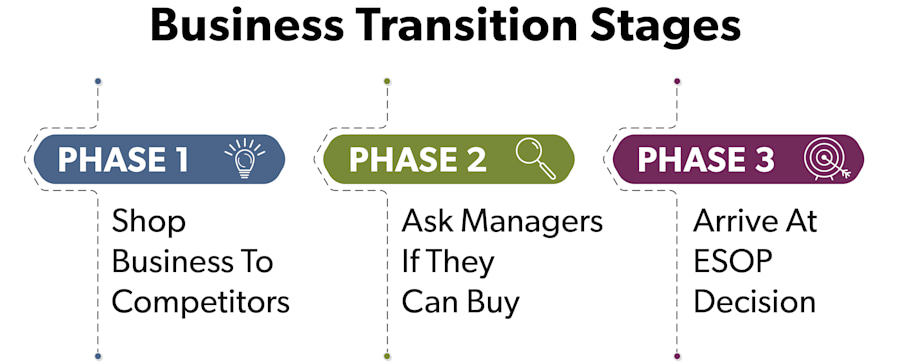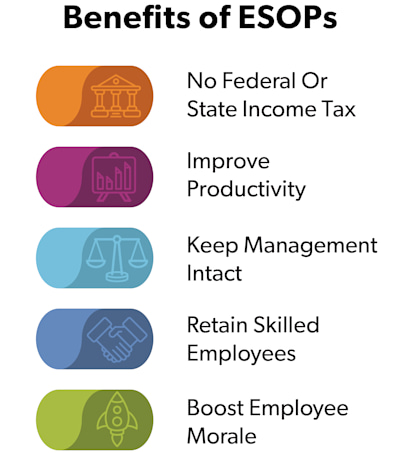As a generation of Baby Boomers gradually transitions to pursue post-work adventures, those who own businesses are faced with transition decisions. Each year, many business owners transfer ownership of their companies to current employees through an Employee Stock Ownership Plan (ESOP), providing an exit strategy and a path to retirement for business owners while returning some benefit to the employees and company.
The Employee Retirement Income Security Act passed in 1974 formally established the ESOPs as a retirement plan. The latest data from the National Center for Employee Ownership (NCEO) show there are almost 6,500 ESOP companies in the United States with 13.9 million participants.
Transitioning Business Ownership to Employees Through ESOP
As outlined by the Internal Revenue Service (IRS), an ESOP is a qualified defined contribution plan like a 401(k). However, the plan contains company stock — employees contribute none of their own funds to the plan. Through an ESOP, a company creates an employee benefit by contributing tax-deductible shares of its own stock. Cash distributions to employees from the ESOP are usually tied to a vesting schedule and the employee can access a certain percentage of the shares for each year of service. After employees leave or retire, the company buys back the vested shares.
At First Business Bank, our teams work with many closely held companies that transfer ownership through ESOPs. Throughout my career working with businesses, I've had the honor of working with several companies in various stages from those considering an ESOP to those with existing ESOP structures. Here are a few common questions business leaders ask about ESOPs.
Q: The Midwest has the highest percentage of ESOPs in the country. Have you found it to be a popular choice of business owners to transfer ownership? Why?
A: Throughout the years, I’ve worked with several clients that have gone through the ESOP process. It’s a popular choice.

When business owners are in the first phase of selling, sometimes they take it to the general market to see if a competitor will buy it. In a good economy, that can bring owners their biggest payday. However, it’s not the most friendly option for the existing management. A competitor purchasing a company will look to cut expenses, reduce redundancy, and potentially cut employees. In my experience, business owners typically move quickly to a second option.
Their second option is often reaching out to the key management team and saying, “Hey, do you want to purchase the company?” Often, they really want to, but sometimes they can’t financially do it.
The third phase down this ESOP path is to preserve value for the business owner while retaining key staff. We often see second or third-generation companies turning to ESOPs at key transition points. It’s not everyone’s choice because sometimes business owners want and need the maximum value for their companies. But sometimes it’s more important to the value of the company to keep key management in place.
Q: What types of companies should consider an ESOP ownership transition? Are there specific instances where it’s not a good idea?
A: An ESOP is a good fit for almost any company, but in my experience, it seems a better fit with companies that have very strong management in place. You’re comfortable having these folks run it and there’s strong and consistent historical cash flow, which can help the valuation process. In my experience, it’s more challenging for cyclical or seasonal businesses, but it can work. ESOPs are much easier to accomplish for a company with a stable management team and predictable cash flow.
Q: What are some benefits of ESOPs for business owners and employees?
 A: The biggest benefit to the business is that ESOPs are not subject to federal and most state income tax, which is a huge advantage.
A: The biggest benefit to the business is that ESOPs are not subject to federal and most state income tax, which is a huge advantage.
ESOPs allow businesses to continue to operate with the same management team, compared to a sale, which is often a very important benefit of business transition. When managers have worked together for decades, keeping them is better for the future of the company. In most cases with ESOPs, business owners maintain a seat on the board of the ESOP so they can still be involved in decisions, which also often is an advantage for the company and managers.
Along with its tax benefits, an ESOP may offer incentives for business owners and their employees. It provides employees ownership interest in the company, which may boost company morale and overall productivity. Increased productivity may improve a business’s bottom line over the long term. Also, employees who feel well-rewarded are more likely to stay, allowing businesses to retain quality workers and reduce employee turnover rates.
Q: What’s important to keep in mind as an owner when considering an ESOP?
A: Timing is important because forming an ESOP is not an overnight process. Business owners need to prepare for many discussions with their trusted advisors, including lawyers and bankers. It’s important to partner with advisors who have experience with ESOPs, who have been through it many times before and can guide you around common pitfalls.
Employee education and communication are also key to a successful ESOP transition. You need a structured plan to fully inform employees about the transition more than a year in advance. I’ve seen a few clients experience major challenges because some employees are resistant to change. You should not spring an ESOP on employees a few months out. The problem is that many business owners have business succession planning on their minds, but they’re running the business, so they often don’t act early enough to communicate and educate employees.
Take into account the initial and ongoing costs of ESOPs. There’s a fee associated with educating employees about an ESOP, costs associated with setting it up through an attorney, and also the financial reporting required. There are also annual valuations required and audits of annual statements.
Q: Statistics show that ESOPs are most common in manufacturing, engineering, and construction. Why is that?
A: I’ve seen ESOPs work in all types of industries, but particularly we do see construction and manufacturing tend to gravitate toward business ownership transition through ESOP. Many of them are multi-generational companies with a strong culture and leadership that are very important to their success. ESOPs are a great way to maintain what they’ve put into place. When you sell to a private equity company or another outside buyer, none of that is guaranteed. Q: Historically, a large percentage of small businesses and family-owned businesses often don’t have succession plans in place, but the pandemic might have brought this issue to the forefront. Do you hear any clients suddenly talking about succession planning?
A: Most businesses are still navigating their businesses through the pandemic. We saw a similar situation in 2008 through 2010. In my experience, it was a few years later, once they got past the recession, that business owners began to actively put ownership transition plans into place. Many were saying to us, “I went through this and I don’t want to do this again.” Once they get out of their rough situations — and this is one of the most challenging times many of them have faced for their businesses — I think many will start to expedite the process of transitioning ownership. As a regular course of business, it’s usually a topic of conversation once they hit a certain age, and a lot of Baby Boomers running companies are trying to find a way to exit. Also, from a valuation perspective, most companies have been affected by COVID-19 and may be at the point where they aren’t the most profitable, so it’s likely more advantageous for the owner to wait a year or so after the bottom of that valuation.
Q: What tips do you give clients about how to navigate succession planning and ESOPs, in particular?
A: Cover all your bases. Look at the other options. Look at potentially a strategic buyout with a competitor. Talk to a business broker about selling your business. Put all your feelers out there at the beginning. While you’re doing that, look at your key management and talk to them about an ESOP. Make sure you consider all other options and find out what’s the best fit for your business from a financial and personal perspective.
Q: Do you see any downsides to an ESOP that would keep you from recommending it to certain clients? Why?
A: You have to be prepared to educate your workforce about ownership transition through ESOP. Business owners should learn a lot about it, and having higher-level business and financial acumen is helpful. There are costs associated with ESOPs — both to create them and ongoing fees — and forming an ESOP is not a quick one-page form you can fill out in one day. Those who aren’t willing to put the time and education into the ESOP process should consider another form of ownership transition.
Q: Anything else to add about succession planning or ESOPs?
A: I always recommend business owners start talking to their partners sooner rather than later. If you’re thinking about ownership transition now, likely it’s a conversation that should have started years ago. ESOPs have helped the companies I’ve worked with in the past in M&A transactions. It’s actually a small competitive advantage when a competitor is looking to purchase the company; having an ESOP can help bridge a gap because the company purchasing knows the employees are invested in it as owners, too.
In conclusion, ESOPs serve as a valuable tool for business owners seeking transition strategies, employees who want a stake in their workplace, and for the growth and sustainability of businesses. By establishing an ESOP, businesses can foster a culture of ownership and shared responsibility, leading to enhanced performance, retention, and overall business continuity.
As we have seen at First Business Bank, when employees are given ownership in the business, they want to see it do well, thus making the ESOP a compelling business model for the modern era.





